
How to get started developing your tourism product
Whether you are offering guided tours, boat rentals, accommodation or provide river cruises, you are offering services to your customers. For today’s tourists, just a service is not enough. They seek experiences, often even experiences that contribute to their quality of life. This document offers you guidelines to identify your customers’ needs and to develop innovative products, services or experiences that really matter to them.
Contents of this page
- Why develop your product with this method?
- This is what you need before you start
- Get inspired by your (potential) customer (Step 1)
- Make a persona for each type of customer (Step 2)
- Identify the core needs of the customers and the key opportunity areas for your business (Step 3)
- Develop a multitude of ideas for solutions, or new products, services or experiences (Step 4)
- Turn your best ideas into prototypes that can be tested and improved step by step (Step 5)
- Test your prototypes in practice (Step 6)
1. Why develop your product with this method?
The needs of tourists from Europe have evolved over the past few decades. Current tourists are looking for quality service and experiences that really matter to them. To offer quality and experiences that matter to your customers, you need to know them very well, personally. What quality means for some may be different from what it means to others. And an experience that is life-changing for some, may be dull to others. This report teaches you how to get in touch with your customers, how to learn what they really need to boost their quality of life, and how you can design products, services or experiences that really matter. The nice thing is that if you succeed, your customers will share their experiences with their friends and followers, also on social media. In other words: they will promote your product to others. For free!
The current coronavirus crisis has put international travel under pressure. In many countries, tourist arrivals have nearly dropped to zero. It is likely that international tourism will be affected by the COVID-19 crisis for the next couple of years. Several scenarios are possible. The frequent holidays made by Europeans to faraway destinations may decrease and this may turn into less frequent and longer holidays closer to home. The battle for tourist visits may become fiercer. The attention for sustainability may also increase. Europeans might be willing to travel longer distances, but only for a very good reason. To tempt potential tourists from Europe to come to your country, your region or your business, you need to stand out, to understand the traveller well and be super-innovative – more than ever. Amazing stories and experiences may become even more important. As will issues of safety, security and assisting tourists in returning to their home countries.
Tip:
- Read more on this in our study on how to respond to COVID-19. This study offers insight into actions you should take immediately, while also providing guidance on long-term decisions.
The method described in this report is based on the principles of design thinking. It has been employed internationally in all kinds of businesses. To mention a few examples in tourism:
- Destinations like the Bahamas (an example is the One-Stop Online Booking and Immigration Card).
- Design for All, also referred to as ‘universal design’, to allow access for people with disabilities. You can read more about this in this thesis.
- Hotels. For example Hyatt Hotels has developed various prototype hotels around the world, which are free from regulation. Another example is The next-generation hotel experience, getting the details right to improve travellers’ stays, and designing a modern work experience for business travellers.
- Visitor attractions, like improving the tourist experience of the Polar Bear Society, a visitor attraction in Norway, or bringing Tourists to a hidden coastal gem.
- Travel and transport. Examples are pioneering a car-sharing service and developing a customer strategy for public transport in Oslo.
- Restaurants, like creating a fresh and modern take on the Indian culinary experience.
- Organisation and development. An example is turning a historic music college into a collaborative learning platform.
- Tourism-related services. An example is the mobile visitor centre in Saint Paul, Minnesota. Another example is to ‘design of waste out of the food system’, taking place in a collaboration between hotels, food banks, foundations, and entrepreneurs to fight food waste.
2. This is what you need before you start
The procedure described below is not difficult. To follow the steps, it helps to have a few basic tools – but only if you already have them) – since it is the idea of how you are doing this that is important.
- Lots of sticky notes (Post-its)
- Markers
- Sheets of flipchart paper
In product development, we try to find a match between the needs of the European market and any of your local situation and business resources that might entail certain limitations. The following tips are related to this.
Tips:
- Where possible, engage your customers to build a personal relationship and to get to know them well.
- If you find it difficult to engage with customers from a different culture or find it difficult to understand them, try to work with local partners who can serve as intermediaries (such as tour operators in source countries) with the guests or act as interpreter.
- Involve others working in your business or in other businesses in the community where you live, people working in education, or other people with an open and positive mind. This will make it more fun and rewarding. It will also contribute to the quality of the work.
- To work through the process described below, you may want to ask support from a local CBI coach and or an intern from a university abroad, for example via SAVE tourism.
Below, the steps are described to help you to develop innovative products and services for new and existing customers. Staying tuned with the market is an ongoing process. The outcomes of each step are illustrated in Figure 1.
Figure 1. From inspiration from your (potential) customers to innovative products and services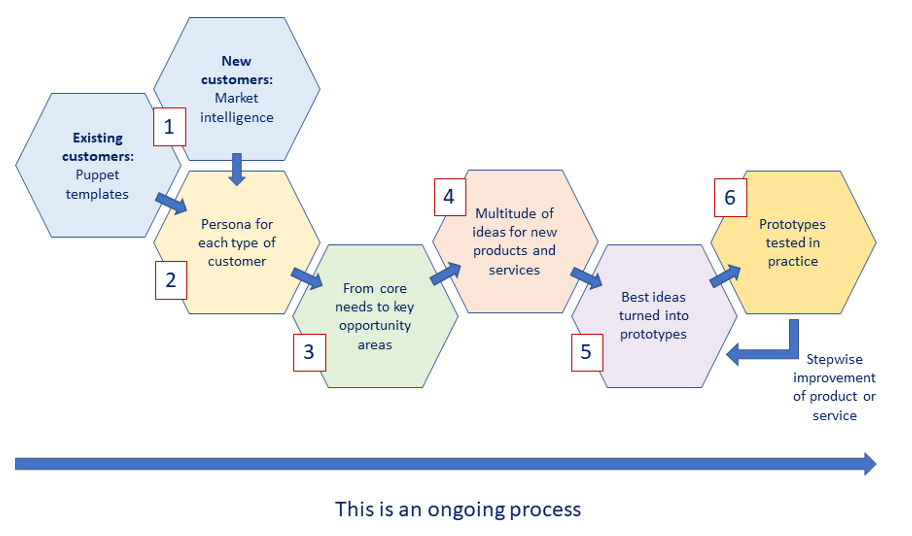
3. Get inspired by your (potential) customer (Step 1)
You can only create meaningful products, services and experiences for your customers if you truly understand them. So try to understand the situations and experiences that are or might be meaningful to them. If you do not have any customers yet, or are looking for new customers, you need to get your inspiration from existing market intelligence (step 1a). If you already have customers, you can use these customers as a source of inspiration (step 1b).
a. Get inspired by potential customers
The largest share of potential customers doesn’t know you or your product offering, or perhaps even the destination. So you have to draw their attention by offering products and services that matter. What do you need to do to make a start?
- Get access to market intelligence reports of the European market. Subscribe to free newsletters or blogs of market intelligence institutions, such as UNWTO, WTTC, Global Sustainable Tourism Council or IATA. Read the annual UNWTO publications, such as Tourism Highlights and World Tourism Barometer.
- Review and read the market intelligence information provided by CBI. This webpage gives access to a CBI trend report and promising market segments and target groups on the European market.
- These sources will help you to identify important (emerging) trends and markets in Europe on a regular basis.
- Try to identify a few target groups or niches that may feel attracted to your business.
b. Get inspired by existing customers
When customers make use of your service business they could also inspire you to make new products. This means that you would need to involve them in the development process. Do not ask them what they want (as they may not know) with a questionnaire, but try to get an idea of the needs they have in a different way.
There are three nice alternative methods you could use, although there are other methods available as well, such as the ones in Ideo’s free Human Centered Design Toolkit. The first time you do so, it might make you feel uneasy to approach a customer. However, always remember that communication with them is key in developing a better product or service.
- It is your duty as an entrepreneur to look after your customers. So you can see it as part of your job to observe your customers during different phases of their customer journey and to learn to understand this customer journey through their eyes. Such observation should be done discreetly and quietly, so as not to disturb or annoy them while enjoying their holiday or business trip. It gives you insights into what they think, what they do, how they interact with others, and what they dream and wish for. While you observe your customers, you can also make notes. Afterwards, you need to find a moment that suits your customer to share your observations in an informal setting, and ask questions about things you did not expect, did not understand, or what they found appropriate. Again, make notes!
- You may also ask your customers whether they would like to help you with improving your services. Ask your customers to take photographs. You could also ask your customers to document their customer journey with a camera and to take pictures of what they consider appropriate products or services. When they give you the pictures, ask them whether there is a suitable moment for them to share some thoughts about these. When you discuss them, do not forget to make notes. Do not insist if a person does not want to cooperate, but try others instead.
- The third approach also requires asking your customers for help in making your services more appealing to them. Ask your customers whether they are willing to take a number of ‘memory cards’ along with them while using your product or service. These cards have to be printed by you beforehand in a kind of postcard format (such as in Figure 2). Ask your customers to fill in a card each time they experience something they did not expect, or which they find very positive or negative. Ask them to return the cards to you by the end of each day or when they leave. If they are open to doing so, ask them whether they have time to share their thoughts with you. If so, be sure you make notes.
Tip:
- Download and make use of the print version of the ‘memory card as shown in Figure 2.
Figure 2. Example of a memory card that you could print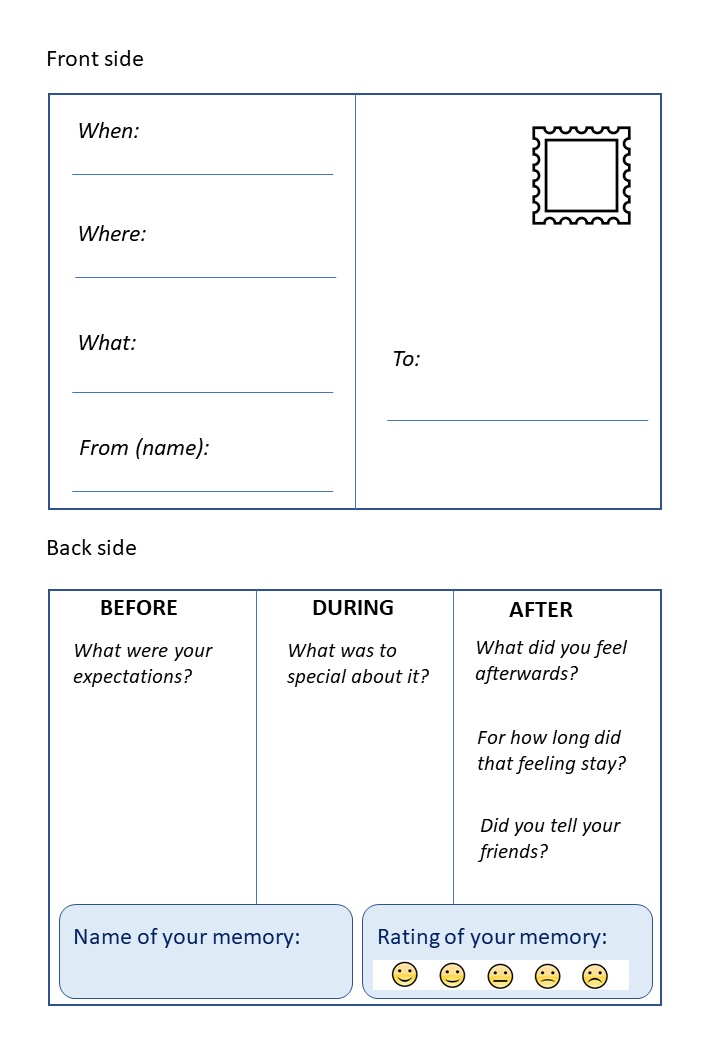
A useful way to describe an individual customer is by using a puppet template. A puppet template is a simple picture of a single customer surrounded by clouds, words bubbles and icons, such as illustrated in Figure 3. Ideally you would make a puppet template together with a customer. This shows that you are open and willing to build a personal relationship with them. A good moment is when you have the chat about the observations, the photographs that they took, or the memory cards that they filled in. During this conversation you could also talk about the person’s age, where they come from, their work, what they do in their daily life, their main interests in life, their worries, their wishes and dreams, or their preferences in tourism. This generates a lot of relevant background information. Take notes! Each customer you talk with gets a separate puppet template.
You will end up with a number of puppet templates. Review the puppet templates and take a closer look at each one. What do you see? You will probably discover that some of the templates are similar to one another. This means that you have already started to understand your customers a little better! Now, group together the puppet templates that show similarities. Each group represents a type of tourist that makes use of your business.
Tips:
- Involve people in your business or community to assist you with understanding the language or the culture of the customer.
- They may help you with making puppet templates and with grouping the templates into types of tourists.
- Download and use of the print version of the puppet template shown in Figure 3.
Figure 3a. Example of a puppet template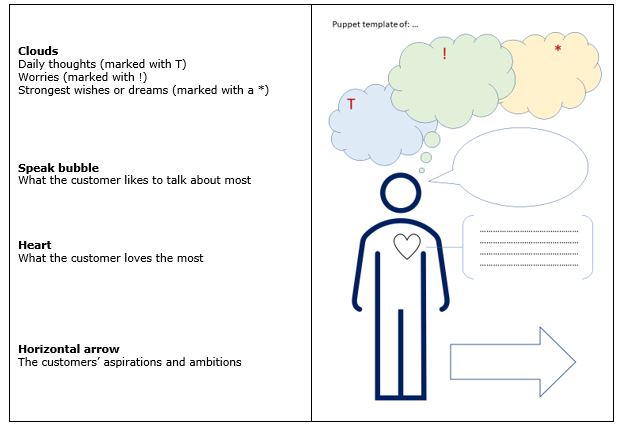
Figure 3b. Example of a filled-in puppet template
4. Make a persona for each type of customer (Step 2)
In the previous step, you grouped the puppet templates with similarities together. Each group represents a type of tourist who could be attracted to your business. Now the challenge is to turn each type of tourist into a market description. You will do this in the form of a so-called persona: one persona for each type of tourist. You might end up with 4-8 personas. You may need to go back to the market intelligence and the puppet templates in step 1 for detailed information. A persona describes each tourist profile, point for point. It would be nice to add a quote on each persona to bring them to life.
A persona includes:
- A nickname
- Profile of the type of tourist
- List of ages & countries or origin
- List of work and ambitions
- Details about personal lives
- List of main interests
- List of wishes, preferences and dreams
- You may want to add photographs (for example from magazines) and quotes that characterise the type of customer
- The use of your business:
- Key locations they went to
- Activities
- Alone? Or with whom?
- Why?
- What did they like and what not?
- Which emotions did they show?
- Key issues, needs, dilemma’s
Most organisations have their own template. The Interacting Design Foundation explains the use of personas in a video. In the figures below, you will find a few examples with different levels of detail and a different style. You can put each persona on a different flipchart sheet.
Figure 4. Example of tourist persona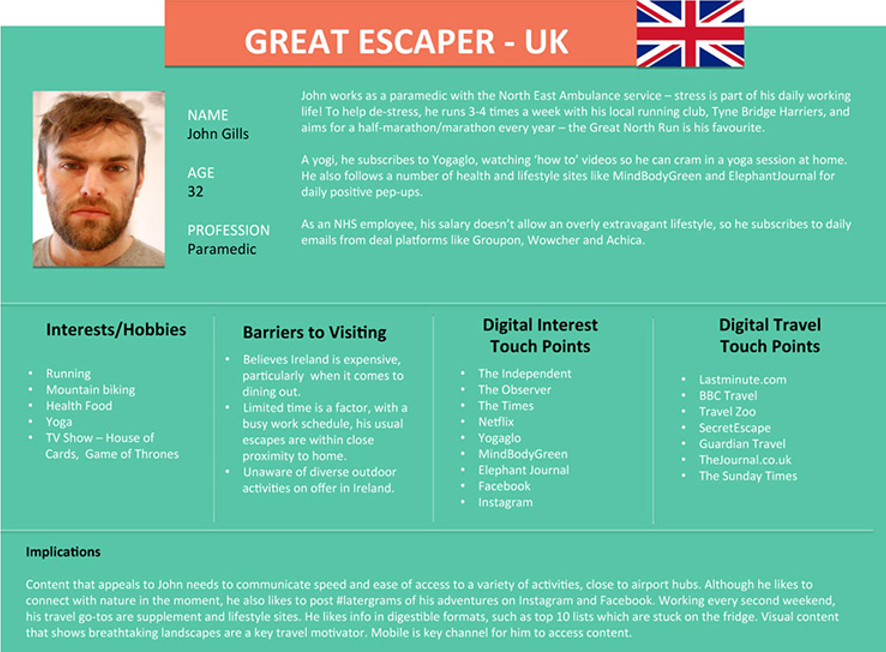
Figure 5. Example of tourist persona
5. Identify the core needs of the customers and the key opportunity areas for your business (Step 3)
Now you need to identify the most prominent needs, hurdles, issues or disappointments of each type of customer (persona).
- Take a closer look at each persona, one by one, and ask yourself the following questions.
- What would be remarkable events and experiences for that persona? What were remarkable events and experiences for that persona?
- What would be stunning likes for that persona? What were stunning likes for that persona?
- What would be striking issues, hurdles, disappointments, wishes or needs for that persona? What were striking issues, hurdles, disappointments, wishes or needs for that persona?
- You may need to go back to the market intelligence and puppet templates in step 1 for possible answers.
- Write each possible answer on a separate sticky note no matter from which persona. Try to get at least 25 sticky notes in total. More would be even better.
- When you are finished, group the Post-its together into areas of which you think they could have a positive impact on your customers’ experiences. Label each grouping of Post-its with a short telegram-style sentence that identifies the impact area. You could write these labels on a Post-it. A label could be, for example: “customers need more personal attention during the excursion”, “customers like to enjoy local cuisine”, or “customers need to be able to connect online”.
- Finally, turn each label into a positive opportunity for your business, also known as an opportunity area, and write it on another Post-it that you put at the top of the label. The header could be for example: “much personal attention during excursion”, “provide local cuisine to the customer”, “adequate Wi-Fi network”.
Tip:
- Try to do this step with your team or with people from the community.
Now you have created opportunity areas for your business! It would be great if you were able to end up with anywhere between two to five such opportunity areas.
6. Develop a multitude of ideas for solutions, or new products, services or experiences (Step 4)
During the previous steps you started with collecting a lot of information that, step by step, you worked into just a few opportunity areas for your business. Now we will try to generate ideas for new products, services or experiences that matter to your customers for each opportunity area. Ideally, you should take this step together with colleagues in your business (not just senior staff!). If you think it is outside the range of your core business, you may also want to involve other businesses in your community.
For a long-term benefit, you first need lots of ideas to get a single good one. This one idea should be innovative and really different from the others. It might be a completely new solution to a problem customers did not even know they had. Do not be satisfied with an obvious solution!
How does it work?
Brainstorm for each opportunity area
Write out each idea on separate Post-its
Sort and group/cluster the ideas that you wrote down
- Brainstorm for each opportunity area that you created in the previous step. Come up with as many ideas as possible. Try to think of weird solutions, products, services or experiences. Never worry whether ideas are right, wrong, absurd or obvious. That hampers your creative flow of thoughts. If you do it with your team you might end up with dozens of ideas.
- Write each idea on a separate Post-it. If it helps you to understand it better, you can make a drawing of what you have in mind.
- Next, sort and group the ideas that you wrote down. Put the bad ideas to the side. Group the ideas that go well together into clusters. Give each cluster a label that tells you what the overarching idea is that the cluster is about. Brainstorming for the opportunity area “provide local cuisine to the customer” could lead to the following labels (Figure 5): start our own restaurant; authentic design of the restaurant; involve local farmers; kitchen staff recruitment and training programme; sustainable waste treatment.
Tip:
- If you take a closer look at the clusters with the labels, you might get ideas about more details. You can write these down on additional Post-its. For example, once you have made a cluster with the label ‘waste treatment’, you may add other ideas: the name of a certification programme you would like to comply with; how you want to adhere to the certification programme; aspects of how you organise the waste flow in the restaurant and kitchen; communication of the certification with the customers, etc. So the labels give you inspiration to add to the clusters to make these more specific.
You will end up with a shortlist of your best ideas for solutions: new products, new services or new experiences. It is a good idea to show the ideas to some of your customers for feedback. In the case of Figure 6, you would end up with the following products and services: authentically designed restaurant (product); strengthened involvement with the community (service and products); collaboration with regional/national educational institutions to train qualified kitchen staff to be skilled at cooking, but to also always pay attention to hygiene rules; a certified waste treatment service.
Figure 6a. Example of brainstorming results for opportunity area ‘provide local cuisine to the customer’ 
Figure 6b. Example of brainstorming for opportunity area ‘provide local cuisine to the customer’, showing clusters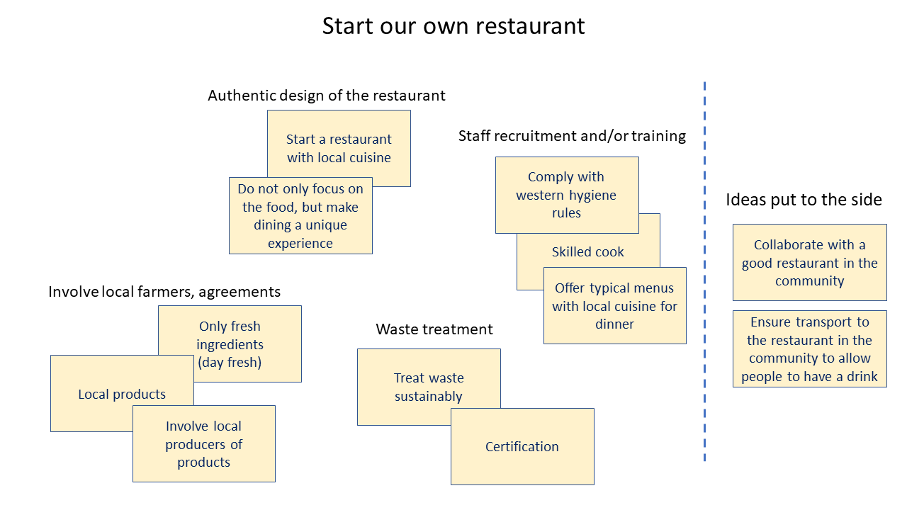
7. Turn your best ideas into prototypes that can be tested and improved step by step (Step 5)
Now is the time to create a first design for the ideas for new products or services that you have created. We call this a prototype. If you make such a detailed design, this will help you to understand your idea better, but also to determine whether you have the resources to implement it, and whether there are any unforeseen challenges or consequences. These things are important for long-term success.
- Select the ideas that could upgrade one of your business’s current products or services or be integrated with such a product or service. These ideas will probably be the easiest to develop because they fit best with your everyday work.
- For each of the products or services that you selected, make a detailed description of how you want it to be designed. We call this a prototype of your product or service.
How do you make a prototype?
- Take a large piece of paper, such as a flipchart sheet, for each of your innovative ideas.
- Draw a cross on each sheet in order to divide it into four quarters. Each quarter is dedicated to one building block of your product or service idea, as illustrated in Figure 5.
- Describe and visualise what each building block would look like according to you. Put your description into a few sentences. Also use a few sketches, drawings and/or cartoons. You can use simple shapes, because the quality of the sketch is not so important at this stage.
Figure 7. The design of your prototype on a flipchart sheet, front side
- On the reverse of each flipchart sheet (Figure 8) you can jot down your ideas on how to link it to the customers in Europe:
- Start with the name.
- Write down the persona(s) who would feel attracted to the product because it matches their needs. You need to go back to the steps you completed earlier.
- Write down an appealing story about your new product or service that can be communicated with the European market. If you have a website, you can put the name and story of your new product/service there.
Figure 8. The design of your prototype on a flipchart sheet, reverse side
Each sheet that you have finished is a prototype of the ideas that you have created for innovations for your business. These are ready to be tested, like the prototype of a new car or airplane that is tested in a wind tunnel.
Never worry that your prototype is incomplete or indistinguishable from the final product that you have in mind. This will be dealt with later in the process.
8. Test your prototypes in practice (Step 6)
The final step is to put your innovative idea into practice and offer it to your customers as you have described and visualised it in your prototype. It is a process of learning by doing. You get feedback from your customers on what worked and what did not. Based on this feedback, you then create a new and improved version of your product, service or experience. Then you once again get feedback and make more improvements. In this way, your product or service will improve step by step.
Tips:
- Do not expect immediate success but accept that you can make mistakes now that otherwise would cost you a lot of money later on.
- See it as a learning process. Be open to the feedback and do not defend your prototype if the users are less positive than you expected. Try to get as much feedback and suggestions for improvement as possible.
- Try to put some speed and efficiency in this phase. This will help you with moving quickly from prototype to putting it to the test, to gathering feedback, and then to making a better version of your product or service.
- Never forget that new trends and new markets will arise. This means that your customer and the needs of your customers may change over the years. This is why you need to restart at step 1 every few years to stay tuned to the needs of the market.
This study was carried out on behalf of CBI by Molgo and ETFI.
Please review our market information disclaimer.
Search
Enter search terms to find market research